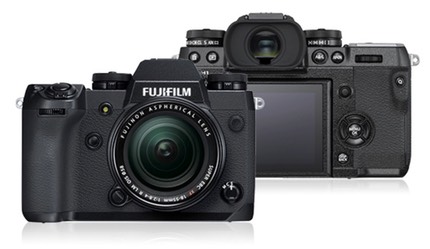Fujifilm today introduced the much-leaked X-H1 model, an upscale model to the X-T2 that was previously regarded by many as the APS-C flagship for the company.

The big changes are the addition of a 5-axis sensor-based IS system (claimed 5.5 stops CIPA), an improved autofocus system for low light, a new 3.7m dot EVF (the X-T2 was 2.4m), and a more robust body build using a stronger frame. The video capabilities have been extended to record at higher bit rates, add a 120 fps HD slow motion capability, add F-log recording, perform face detection while recording video, and more. A new "film simulation," Eterna has been added.
Plenty of small things have been tweaked, as well. The X-H1 body is a bit bigger and heavier than the X-T2, with improved ergonomics, including a new top LED. The exposure compensation dial has been removed and Fujifilm moved to the Nikon-style button+dial design for that. Electronic first curtain shutter, flicker detection, Bluetooth, and a touchscreen capability have been added, as well.
The new X-H1 body is bigger in all dimensions than the X-T2, and it adds about 6 ounces (170g) in weight.
Price for the new body is US$1899.
A number of Nikon supporters challenged me on my assertion late last year that Nikon needed to come out with a D500s model early this year. The X-H1 is one of the reasons why. Nikon has not defended the APS-C speed camera position particularly well, producing neither the lenses that the D500 really needed, as well as failing to do the kind of push-hard incrementation that Fujifilm has been pursuing and which has now produced the very nicely specified X-H1. I'd say that the X-H1 is fairly squarely aimed at cameras like the D500, which is now two years old.
Fujifilm is trying to win with technology, features, and performance. In the near US$2000 price point we have the Olympus E-M1 Mark II and the Nikon D500 as the primary competitors taking that approach. In many ways, Fujifilm is benchmarking those competitors and adapting many of their best traits.
Whether that turns into real volume for Fujifilm is still to be seen. Nikon's better dealer network has them still in the mid-twenties in terms of ILC camera sales percentage, while Fujifilm still sits in single digits. Still, in marketing perception is everything, and I'm pretty sure that everyone's perception of Fujifilm at this point is that they're adding capability and performance at every model iteration and now able to match many competitors head on. Coupled with their wide range of X lenses—a bigger and better selection of APS-C lenses than Canon, Nikon, or Sony can claim—that bodes well for them.
Indeed, Fujifilm has done what everyone else except Canon and Sony haven't: produced true video lenses for the X series. Announced with the X-H1 were two cinema lenses, the MKX18-55mm t/2.9 and 50-135mm t/2.9. Both these lenses were previously sneaked for the Sony FE mount earlier, but now will appear in X mount cladding, as well.
I do have to wonder if Fujifilm is making the same mistake that Olympus made, though. Rumors already are floating about an X-T3 later this year, which will leapfrog the X-H1 in a number of features (and megapixels). This is similar to the E-M1/E-M5 leapfrogging that's been going on across town. The problem is this: if these are really different body entries, they're not highly discriminated, and essentially Fujifilm and Olympus are encouraging their user base to churn on buying constant upgrades.
Fujifilm has crammed a lot of bodies into a small space (US$900-1900): X-E3, X-T20, X-T2, X-H1, X-Pro2. I don't think they can all survive long term, so what really are the core models here?
Finally, Fujifilm also announced major firmware updates for the GFX (version 3.0) and X-T20 (version 2.0).
Support this site by purchasing from the following advertiser: